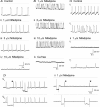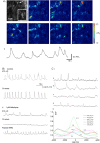Spontaneous electrical and Ca2+ signals in typical and atypical smooth muscle cells and interstitial cell of Cajal-like cells of mouse renal pelvis
- PMID: 17656432
- PMCID: PMC2277191
- DOI: 10.1113/jphysiol.2007.137034
Spontaneous electrical and Ca2+ signals in typical and atypical smooth muscle cells and interstitial cell of Cajal-like cells of mouse renal pelvis
Abstract
Electrical rhythmicity in the renal pelvis provides the fundamental drive for the peristaltic contractions that propel urine from the kidney to bladder for storage until micturition. Although atypical smooth muscles (ASMCs) within the most proximal regions of the renal pelvis have long been implicated as the pacemaker cells, the presence of a sparsely distributed population of rhythmically active Kit-positive interstitial cells of Cajal-like cells (ICC-LCs) have confounded our understanding of pelviureteric peristalsis. We have recorded the electrical activity and separately visualized changes in intracellular Ca(2+) concentration in typical smooth muscle cells (TSMCs), ASMCs and ICC-LCs using intracellular microelectrodes and a fluorescent Ca(2+) indicator, fluo-4. Nifedipine (1-10 microm)-sensitive driven action potentials and Ca(2+) waves (frequency 6-15 min(-1)) propagated through the TSMC layer at a velocity of 1-2 mm s(-1). High frequency (10-40 min(-1)) Ca(2+) transients and spontaneous transient depolarizations (STDs) were recorded in ASMCs in the absence or presence of 1 microm nifedipine. ICC-LCs displayed low frequency (1-3 min(-1)) Ca(2+) transients which we speculated arose from cells that displayed action potentials with long plateaus (2-5 s). Neither electrical activity propagated over distances > 50 microm. In 1 microm nifedipine, ASMCs or ICC-LCs separated by < 30 microm displayed some synchronicity in their Ca(2+) transient discharge suggesting that they may well be acting as 'point sources' of excitation to the TSMC layer. We speculate that ASMCs act as the primary pacemaker in the renal pelvis while ICC-LCs play a supportive role, but can take over pacemaking in the absence of the proximal pacemaker drive.
Figures











Similar articles
-
Spontaneous electrical and Ca2+ signals in the mouse renal pelvis that drive pyeloureteric peristalsis.Clin Exp Pharmacol Physiol. 2010 Apr;37(4):509-15. doi: 10.1111/j.1440-1681.2009.05226.x. Epub 2009 Jun 8. Clin Exp Pharmacol Physiol. 2010. PMID: 19515061
-
Pyeloureteric peristalsis: role of atypical smooth muscle cells and interstitial cells of Cajal-like cells as pacemakers.J Physiol. 2006 Nov 1;576(Pt 3):695-705. doi: 10.1113/jphysiol.2006.116855. Epub 2006 Aug 31. J Physiol. 2006. PMID: 16945969 Free PMC article. Review.
-
Role of Ca2+ entry and Ca2+ stores in atypical smooth muscle cell autorhythmicity in the mouse renal pelvis.Br J Pharmacol. 2007 Dec;152(8):1248-59. doi: 10.1038/sj.bjp.0707535. Epub 2007 Oct 29. Br J Pharmacol. 2007. PMID: 17965738 Free PMC article.
-
Role of interstitial cells and gap junctions in the transmission of spontaneous Ca2+ signals in detrusor smooth muscles of the guinea-pig urinary bladder.J Physiol. 2004 Sep 1;559(Pt 2):567-81. doi: 10.1113/jphysiol.2004.065136. Epub 2004 Jul 2. J Physiol. 2004. PMID: 15235094 Free PMC article.
-
Pacemaker Mechanisms Driving Pyeloureteric Peristalsis: Modulatory Role of Interstitial Cells.Adv Exp Med Biol. 2019;1124:77-101. doi: 10.1007/978-981-13-5895-1_3. Adv Exp Med Biol. 2019. PMID: 31183823 Review.
Cited by
-
A molecular signature of tissues with pacemaker activity in the heart and upper urinary tract involves coexpressed hyperpolarization-activated cation and T-type Ca2+ channels.FASEB J. 2014 Feb;28(2):730-9. doi: 10.1096/fj.13-237289. Epub 2013 Nov 4. FASEB J. 2014. PMID: 24189942 Free PMC article.
-
Hyperpolarization-activated cation and T-type calcium ion channel expression in porcine and human renal pacemaker tissues.J Anat. 2016 May;228(5):812-25. doi: 10.1111/joa.12444. Epub 2016 Jan 25. J Anat. 2016. PMID: 26805464 Free PMC article.
-
Artificial urinary conduit construction using tissue engineering methods.Cent European J Urol. 2015;68(1):109-14. doi: 10.5173/ceju.2015.01.448. Epub 2014 Dec 31. Cent European J Urol. 2015. PMID: 25914849 Free PMC article. Review.
-
Serotonin augments gut pacemaker activity via 5-HT3 receptors.PLoS One. 2011;6(9):e24928. doi: 10.1371/journal.pone.0024928. Epub 2011 Sep 15. PLoS One. 2011. PMID: 21949791 Free PMC article.
-
Control of urinary drainage and voiding.Clin J Am Soc Nephrol. 2015 Mar 6;10(3):480-92. doi: 10.2215/CJN.04520413. Epub 2014 Apr 17. Clin J Am Soc Nephrol. 2015. PMID: 24742475 Free PMC article. Review.
References
-
- Constantinou CE, Neubarth JL, Mensah-Dwumah M. Frequency gradient in the autorhythmicity of the pyeloureteral pacemaker system. Experientia. 1978;34:614–615. - PubMed
-
- David SG, Cebrian C, Vaughan ED, Herzlinger D. C-kit and ureteral peristalsis. J Urol. 2005;173:292–295. - PubMed
-
- Dixon JS, Gosling JA. The fine structure of pacemaker cells in the pig renal calices. Anat Rec. 1973;175:139–153. - PubMed
Publication types
MeSH terms
Substances
LinkOut - more resources
Full Text Sources
Miscellaneous

